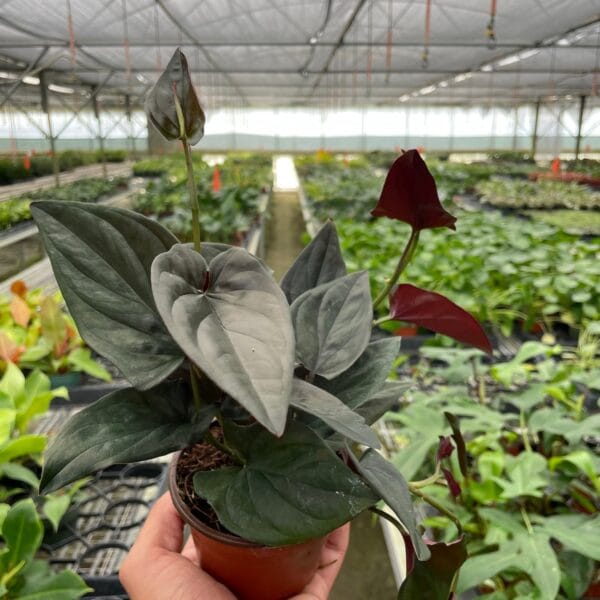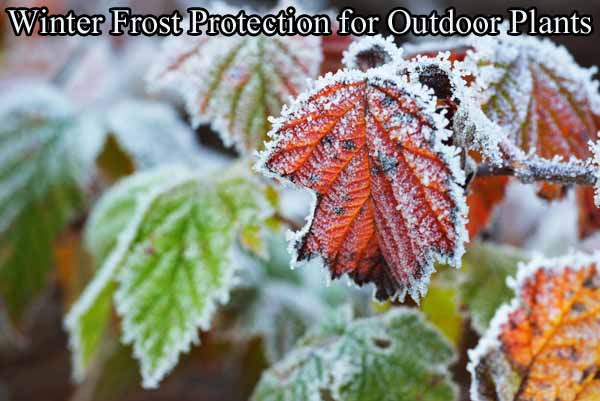-
×
 Hoya 'Black Margin' 1 × $27.75
Hoya 'Black Margin' 1 × $27.75 -
×
 Syngonium 'Red Arrow' 1 × $34.75
Syngonium 'Red Arrow' 1 × $34.75
Newsletter Articles
Winter Frost Protection for Outdoor Plants
Written by Marge B.
Anyone living in California knows that the weather is subject to change. Even though temperatures are moderate in Southern California, there are occasions when there are dramatic temperature deviations from normal. Frost occurs when the air is warmer than 32°degrees Fahrenheit, which causes the temperature of the plant tissue to drop, because plants lose heat to the atmosphere, especially during cool, clear nights. As a gardener, get to know your plants inside and out. Some trees and shrubs are tough enough for extreme temperatures. A few of these plants include Pigeon Point Coyote Brush. Between August and December, this woody perennial evergreen produces yellowish male flowers. It is drought tolerant in coastal areas but prefers moderate watering inland. The Coyote Bush is a perfect sunscreen and good for soil retention. Another shrub to consider is the Dark Star California Lilac. This shrub has attractive dark green evergreen foliage and blue star-shaped flowers. The oval leaves are highly ornamental and stay dark green during the winter months. Dark Star California Lilac is a dense, closely compacted evergreen shrub. This shrub provides an attractive addition to the landscape. The Dark Star Lilac adding one or two trees or shrubs next to the Dark Star Lilac creates a striking look to your landscape.
Plants and shrubs that are native to your immediate location can easily adapt to Southern California’s yearly climate variations. California native plants can adapt to low winter temperatures and the triple digit heat of the summer months. Even in Southern California, frost can affect your garden, but careful garden preparation can save your outdoor plants. Discover what areas of your yard are warm and which areas are cold. Low spots in the yard and enclosed areas that trap cool air and hold it are the part of your yard that is more subject to frost that could bring damage to your plants. In your yard, the south-facing exterior walls of your house will absorb the heat and sunlight during the day and warm the ground in that area at night. Some plants will be able to survive cold temperatures if they are established. It is important that you make sure to protect the roots of your outdoor plants. Native California plants such as Mystic Spires Blue Sage and Raspberry Ruby Sage also known as Ruby Salvia will tolerate frost if they are well established.
Plants that have adapted to frost include winter deciduous species, like most, the oak, spice bush, Snowberry which is a durable and hardy small shrub that produces small pink flowers and showy white berries in fall and into winter. The Snowberry can grow to a height of 5 feet. Another hardy shrub is the Wild Grape. It blooms in late spring with showy pink grape-like bunches, but be cautious because the berries are toxic. The Wild Grape has attractive grayish green leaves with white undersides which emerge plum purple in spring. The large serrated pointy leaves are highly ornamental. The peeling gray bark is extremely showy and adds an interesting appearance in the winter.
Your outdoor plant’s typical reaction to chilly weather is to stop growing, but, underneath the soil, the roots continue to grow even when it is chilly. It is possible for many shrubs and evergreens to produce roots during frosty weather. That is why it is important to cover the top layer of the soil, and it is covered with mulch, twigs, or leaves. This will protect the roots. Some of the shrubs in your garden might show signs of frost-burn, which might look like sun-browned patches on leaves and stems. Typically, these damaged leaves will naturally fall off as the weather begins to warm. You should not plant vegetation that is smaller than a one-gallon size when the weather predicts freezing temperatures. If you plant in December, remember to mulch the plants and flower beds to protect the roots. If frosty temperatures occur, the mulch on the top of the soil will protect the roots and crown of the plants below the mulch ground cover. It is important to take care to prepare the soil for the chilly winter. It is important to mulch your plants before the chill of frost. Remember to the soil heavily around new plants with at least four inches of mulch, twigs, rocks, or gravel. You can also cover your delicate plants with frost-protection fabric. If you do cover your landscape items with fabric protection, make sure that the cover reaches the ground and fasten it firmly to prevent chilly air from reaching the plants that are covered. It is important to leave your irrigation system on in the winter but adjust the time because plants will require less water in freezing weather, but watering will help keep the soil warm. If the local weather predicts freezing temperatures, do not water in the afternoon or evening. It is important to water your plants after freezing weather because the frost can dry out the soil. Keeping the roots of your trees and shrubs moisture is the safest way to protect them during chilly weather. It is important to feed and water your plants during their growing season. For most plants, this is in the spring and summer months. You should remember to discourage any new plant growth in the winter. Plants that appear actively growing in the winter are more susceptible to cold and frost than plants that are dormant. Be aware of the signs that frost is coming. These signs include still air. You can visibly see that trees are not swaying in the wind. Your tree branches are motionless, there are no visible clouds, the stars appear very bright, and the humidity is low. When you notice these signs, be aware that frost at night is coming. Be sure to move any delicate plants into the shelter of a porch or garage until the climate changes.
If your plants show damage after a frost, it is important not to prune them too early. Trimming your plants too soon after a frost might damage the new growth of your plants. It is best to wait until new growth appears in the spring because then it will be easier to remove the parts of the plants that are clearly dead without making a mistake and cutting away new growth.
The landscape design experts at Green Thumb Nursery provide innovative Landscape Design Services, The landscape experts can advise you about your seasonal outdoor and indoor plant care. For a limited time, when a customer purchases a $750 Green Thumb gift card, they get a free professional landscape design. Appointments are required, and the calendar is filled up, so Book your appointment now before it is too late! At the Green Thumb location in Orange County, the nursery staff’s mission is to help homeowners enhance and beautify their outdoor space with functional landscape design. As a home’s exterior space improves, the home’s property value also increases. Landscape design meetings take place at the Green Thumb Nursery in Lake Forest. These design meetings require approximately 1 hour.
Do you like what you see? Sign up for our weekly newsletter to get content like this every week!


 Hoya 'Black Margin'
Hoya 'Black Margin'  Syngonium 'Red Arrow'
Syngonium 'Red Arrow' 